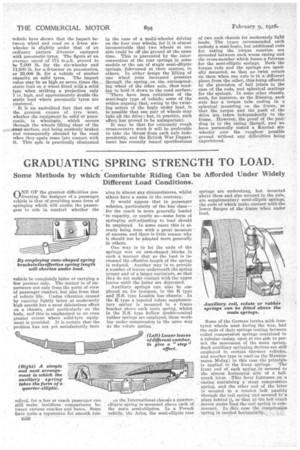GRADUATING SPRING STRENGTH TO LOAD.
Page 40

If you've noticed an error in this article please click here to report it so we can fix it.
Some Methods by which Comfortable Riding Can be Afforded Under Widely Different Load Conditions.
OONE OF the greatest difficulties con. the designer of a passenger vehicle is that of providing seine form of springing which will enable the passengers to ride in comfort whether the
vehicle be completely laden or carrying a few persons only. The matter is of importance not only from the point of view of passenger comfort, but also from that of vehicle life. Undue vibration caused by running lightly laden at moderately high speeds has a most deleterious effect on a chassis, and particularly on the body, and this is emphasized to an even greater extent where solid-tyre equipment is provided. It is certain that the problem has not yet satisfactorily been solved, for a bus or coach passenger can still make invidious comparisons between various coaches and buses. Some have quite a reputation for smooth run ning in almost any circumstances, whilst others have a name to the contrary.
It would appear that in passenger vehicles, particularly of the bus class— for the coach is more generally loaded to capacity, or nearly so—some form of springing self-adjusting to load should be employed. In i017fte cases this is already being done with a great measure of success, and there is little reason why it should not be adopted more generally in others.
One way is to let the ends of the springs rest on cam-shaped ;blocks in such a manner that as the load is increased the effective length of the spring is reduced. Another way is to provide a number of leaves underneath the spring proper and of a larger curvature, so that they do not make contact with the upper leaves until the latter are depressed.
Auxiliary springs can also be employed as, for instance, in the K type and N.S. type London bus chassis. In the K type a tapered volute supplementary spring is mounted in a frame bracket above each main spring, whilst in the N.S. type hollow double-conical rubber springs are employed, these working under compression in the same way as the volute spring.'
LO the International chassis a quarterelliptic spring is mounted above each of the main semi-elliptics. In a French vehicle, the Aries, the semi-elliptic rear
springs are underslung, but mounted above them and also secured to the axle, are supplementarY semi-elliptic springs, the ends of which make contact with the lower flanges of the frame when under load.
Some of the German lorries with irontyred wheels used during the war, had the ends of their springs resting between
• coiled compression springs contained in a tubular casing, open at one side to permit the movement of the main spring. Such auxiliary springing devices are still employed in certain -German vehicles, and another type is used on the Mannesmann. Mula.g; in this case the principle is applied to the front springs. The front end of each spring is secured to the almost horizontal arm of a bellcrank lever. --This lever fulcrums on a casing containing a stout compression spring, and the other end of the lever is secured to a tension bolt passing through the coil spring and secured to a place behind it, 80 that as the bell crank moves under load the coil spring is-cornpressed. In this case the compression spring is carried -horizontally.


























































